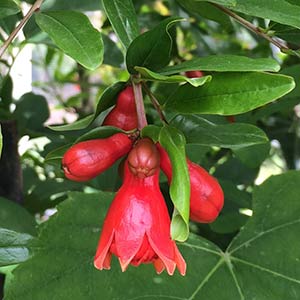
Easy to grow Pomegranate trees are perhaps best described as shrubby and hardy.
They require little water once established and will need to be pruned if you wish them grow into a small tree rather than a shrub.
Grown for pomegranate fruit and juice as well as for ornamental purposes, Pomegranate Trees are generally hardy and once established are reasonably drought tolerant.
They will grow in cooler climates, however for best fruit they prefer areas with warmer summers, which is why major plantings are in California. As A guide, USDA Zones 7 – 10 are suitable.
The fruit the pomegranate can be eaten fresh or juiced, but look for the sweeter species such as Gulosha Rosavaya, Wonderful and Gulosha Azerbaijani.
Pomegranate juice (grenadine) is high in antioxidants.
Care
Pomegranate Trees are best grown from proven trees rather than pomegranate tree seeds. Some pomegranates have much sweeter juice than others so it is worth looking for sweeter species.
Growing Conditions For Pomegranate Trees
Planting and pruning Pomegranate trees is fairly simple, a humus rich well drained soil is best, water well when establishing and fertilise with an all purpose fertilizer.
- Choose a warm sunny position with a well drained soil.
- Dig in good amounts of compost and other material to improve water holding potential of the spoil.
- For the first two summers you will need to water during dry periods until good root systems are established.
- Use a nitrogen rich fertilizer for the first thee years to promote quick growth. After that pomegranate trees will grow well with an annual application of mulch and compost.
Pruning
Pomegranate Trees can be pruned or cut back after fruiting, although they generally only need pruning to maintain shape in the home garden. Pomegranate trees can be an interesting subject for espalier.
If you are pruning to a tree shape you will need to establish which stem will be the leader as as early as possible. Lift the branches to around 2 ft from the ground over the first three years and then prune to create a branch structure. This type of pruning is for aesthetics rather than to improve fruiting.
They are so easy to prune, and respond so well that you can actually prune them as a semi formal hedge if you wish.
As most varieties are grafted, you will need to remove suckers as they appear.
Varieties
The sweeter varieties are generally the best and these include :
- Gulosha Rosavaya. – Large attractive fruit, good acidity and sweetness.
- Wonderful. – Large fruit, sweet an tasty and excellent in hot dry climates.
- Gulosha Azerbaijani. – Large fruit, light pink to red sweet and slightly acidic.
- Sharp Velvet – Large fruit, deep red flesh.
- Eversweet – Although this variety has very few seeds, so you miss out on those tiny red jewels.
Propagation
Mostly grafted for best fruiting ability.
Pomegranate trees are available for sale from the following specialist nurseries.
FOUR WINDS GROWERS
phone: 877-449-4637 ext. 1
www.fourwindsgrowers.com

